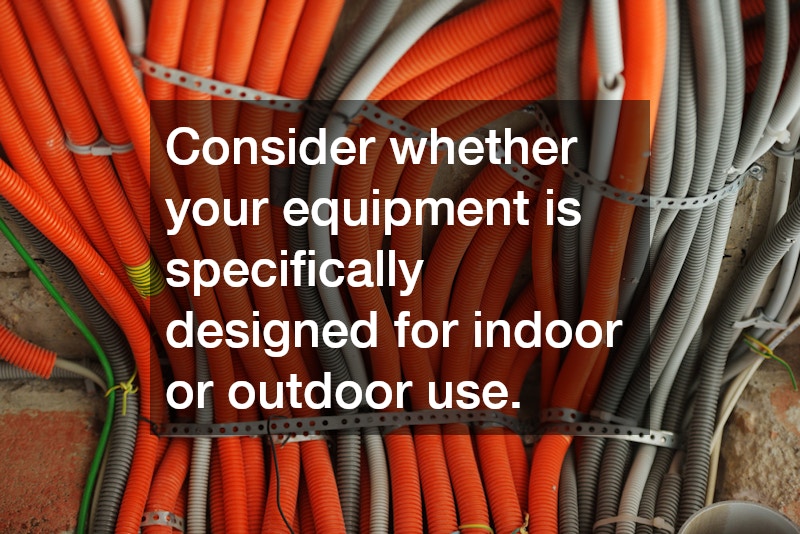Before diving into the specifics of choosing a power cord, it’s crucial to understand the basics. Power cords come in various types and specifications, each designed for a particular application. Familiarity with components such as plugs, connectors, and ratings ensures a well-suited choice. It’s also essential to know the voltage and current your project demands. Regardless of the project size, using the correct cord type can save time, money, and prevent potential hazards.
When considering the purchase of a power cord, you first need to identify the equipment requirements. Determine if your equipment needs a grounded cord or if it can function without it. This distinction will help you choose between a three-prong or a two-prong plug. Furthermore, consider whether your equipment is specifically designed for indoor or outdoor use. Indoor cords should not be used for outdoor projects due to their vulnerability to environmental factors.
Another fundamental aspect is the cord gauge, which indicates the thickness of the wire within the cord. A lower gauge number signals a thicker wire, which can handle more current, reducing overheating risks. Familiarize yourself with the American Wire Gauge (AWG) system, as it’s commonly used in power cords. Selecting the right gauge is particularly important for high-powered tools, like heavy-duty power equipment, that draw significant current. This ensures efficiency and safety, allowing you to complete your projects without a hitch.
Determining the Right Length and Thickness
After mastering the fundamentals, the next consideration is the appropriate length and thickness of your power cord. The length of the cord directly affects its performance; hence, it should be optimized for your workspace. A cord that’s too long could lead to voltage drops, while a cord that’s too short may not allow flexibility in tool placement. Consider measuring the distance between your power source and the apparatus to determine the optimal cord length.
In addition to length, cord thickness also plays a pivotal role in its performance. A thick or heavy duty cord can handle higher currents, making it ideal for demanding projects. These cords are crucial if your equipment has a higher amperage rating. Beyond performance, thicker cords are also generally more durable and can withstand more wear and tear, which is especially beneficial in construction or industrial settings. Ensure the cord is suited to the specific needs of your project and environment.
If you’re planning projects that may involve moving the machinery or crossing obstacles, consider flexible cords that can adapt to changing scenarios. While thicker cords may appear less flexible, several are designed to offer both resilience and a degree of pliability. Investing in quality power cords will reduce frequent replacements and ultimately become a more cost-effective solution over time. Always assess not just the immediate, but also potential future requirements, ensuring that your cord can accommodate any unforeseen changes. This forward-thinking approach to purchasing will serve you well in maintaining productivity and safety.
Ensuring Safety Standards and Certifications
Safety should always be a priority when selecting a power cord. Look for cords that come with UL (Underwriters Laboratories) or ETL (Electrical Testing Laboratories) certifications. These certifications ensure that the cords meet certain safety standards and have been tested for performance. Using non-certified cords can pose significant risks, including electrical fires or equipment damage. Protecting both your equipment and your workspace is essential for achieving successful project outcomes.
Be sure to inspect the cord for additional safety features such as insulation and strain relief. Insulation provides a safety layer that minimizes the risk of electric shock. Strain relief components help prevent the cord from being pulled out of the plug or connector. This is especially crucial for projects involving significant movement or weight. A heavy-duty cord with adequate insulation and strain relief protects both the user and the equipment.
When choosing cords for use in potentially hazardous areas, it’s important to select those specifically designed for extreme conditions. Some heavy-duty cords are equipped to handle exposure to chemicals, oil, or extreme temperatures. These types are indispensable in industrial or laboratory environments where standard cords may fail. Availability of these specialized cords ensures that you can find the perfect fit for your specific project needs, without compromising on safety. Considering these safety factors can substantially reduce risks and contribute to long-term project success.
Making the Final Decision
By now, you should be equipped with enough information to make an informed decision on the type of power cord your project requires. Start by reassessing your priority needs, such as project scope, safety concerns, and equipment specifications. Remember, a well-chosen heavy-duty cord not only enhances performance but also extends the longevity of your equipment. An investment in a high-quality cord is an investment in the efficiency and safety of your workspace.
It’s critical to balance quality with budget when finalizing your choice, as the cost shouldn’t dictate a compromise on safety and efficacy. Opt for trusted brands that offer warranties and customer service support. This way, you have assistance ready in case any unforeseen issues arise. Also, read user reviews to see real-life experiences and feedback on specific models. Reviews can provide insight beyond the manufacturer’s description, highlighting the product’s advantages and potential drawbacks.
Finally, once you have obtained the power cord, perform a preliminary check before usage. Inspect for any visible damage and test its functionality with your equipment in a controlled environment. Establishing a routine inspection culture ensures the cord remains in a safe working condition throughout its lifespan. With all these considerations, you’re now prepared to confidently and safely power your projects, knowing you’ve selected the appropriate heavy-duty cord for your needs.

